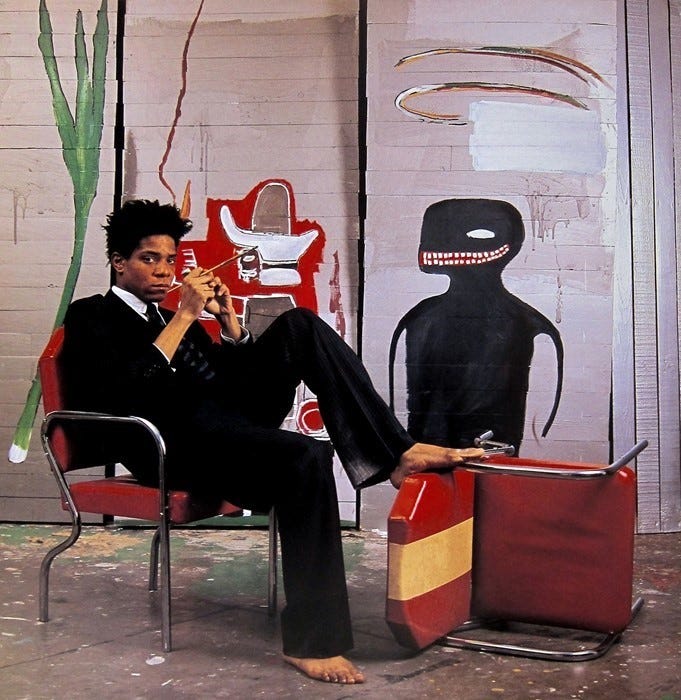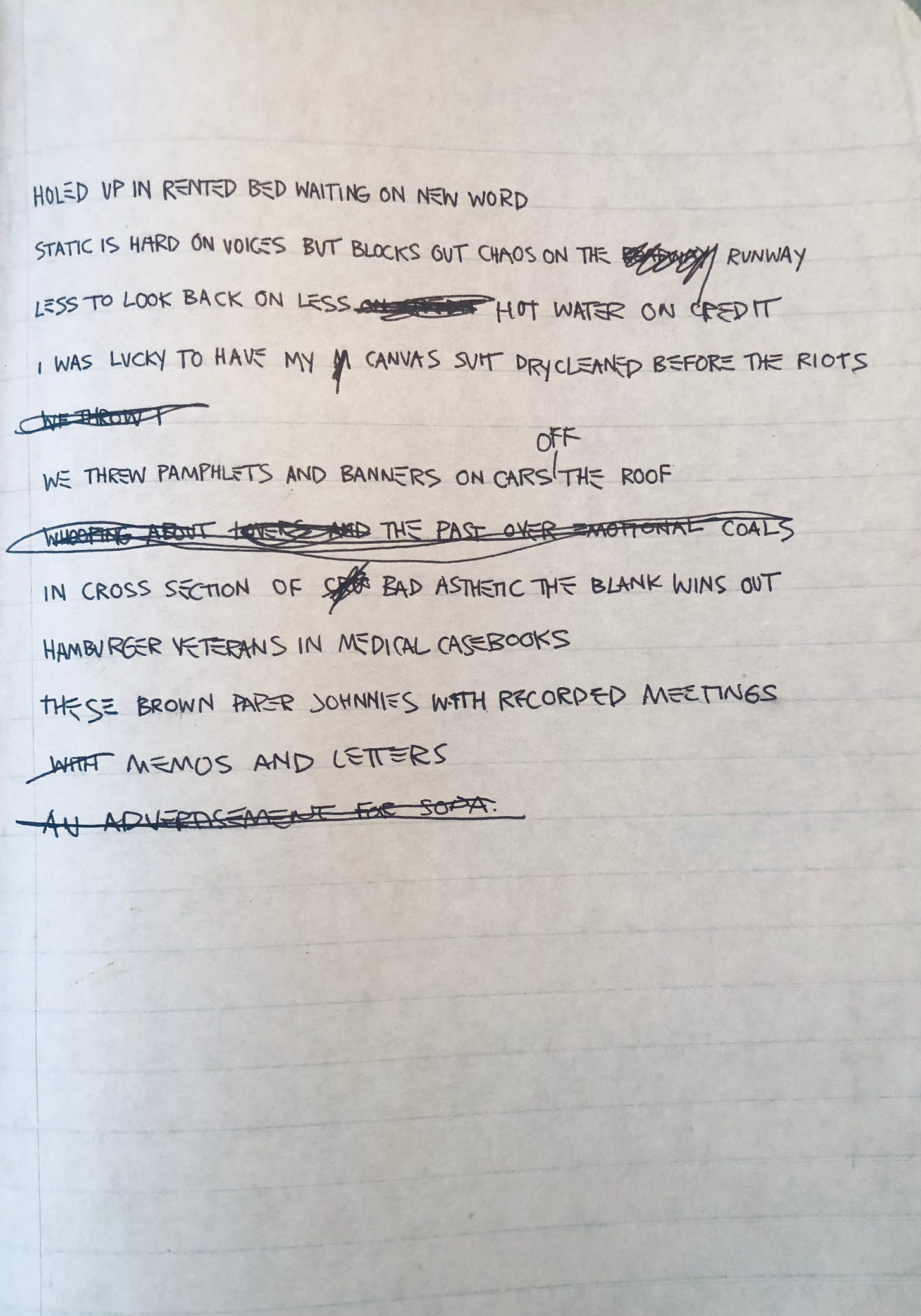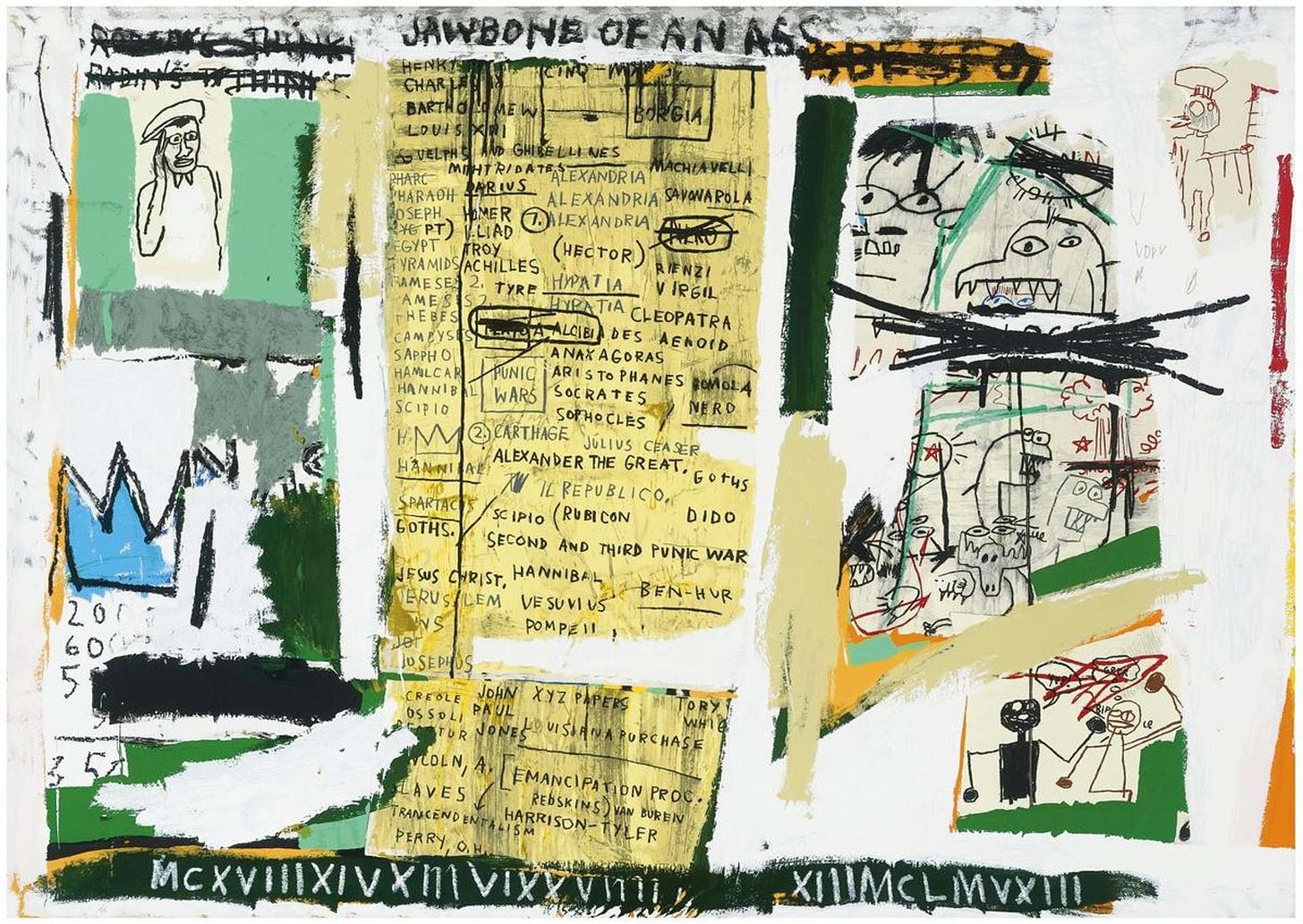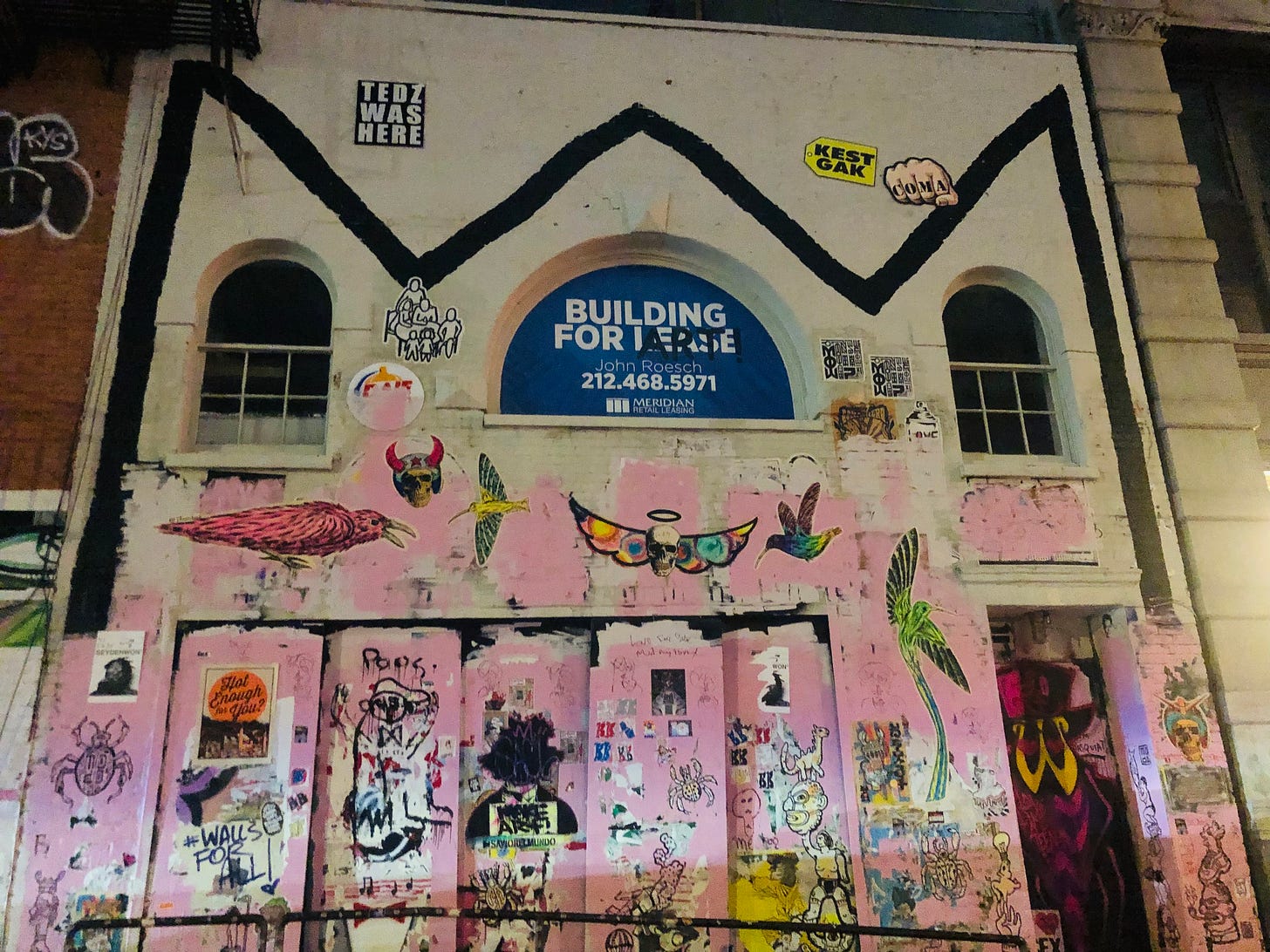Jean-Michel Basquiat's Notes from NYC's Underground Art Scene
Jean-Michel Basquiat's Notes from NYC's Underground Art Scene
Excerpt
"IT’S TIME TO GREYHOUND AND COME BACK A DRIFTER"
Too often, we think of notebooks as a way-station: a necessary stop en-route to the perfected, polished work of art. But what if the notebook is the work of art? What if the process of taking notes is the point?
There is no better artist for thinking through the notebook as an art object than Jean-Michel Basquiat (1960-1988).
[

Basquiat in 1985. From ‘New Art, New Money,” The New York Times Magazine
Not only are his notebooks beautiful, coherent works of art, but his paintings are extensions of the notebook page. As Esteban Jefferson explained, “The canvas becomes more like a gigantic notebook.”
And Basquiat’s notebooks were miniature canvases. They are filled with brilliant, evocative lines drawn from his life.
I FEEL LIKE A CITIZEN IN THIS PARKING LOT COUNTRY FAIR
IT’S TIME TO GREYHOUND AND COME BACK A DRIFTER
PUT IT ALL IN ONE BAG
All of Basquiat’s notebooks contain his neat, block capital letters on the right-hand page. He would leave much of the page blank. His lines of poetry, floating.
Henry Louis Gates Jr. writes: “Reading his notebooks feels voyeuristic until you realize that Basquiat was determined from a young age to be famous.”
And Basquiat became wildly famous. His paintings are among the most expensive in the world. “Untitled Skull” sold for a record breaking $110,487,500:
[

Jean-Michel Basquiat, Untitled, 1982
During his short life, Basquiat revolutionized the art world and produced 600 paintings that tapped into the gritty, creative underground scene that developed in NYC during the 70s and 80s.
He also left behind 160 pages of notes. Let’s take a look at some of them.
Basquiat came of age in a New York on the brink of ruin. Bankrupt, the government cut social services and education. Violence was at an all-time high. And the city was literally on fire: the Bronx was burning as derelict landlords set fire to buildings to collect insurance money. Further south, the East Village had been abandoned. Struggling artists, who couldn’t afford rent, found a home there.
Amid this wreckage, underground culture flourished. Hip-hop was born with its cross-fertilization of the arts—its empowering political message reverberated across the city. I’ll cover Basquiat’s relationship with hip-hop and jazz in this week’s postscript.
Basquiat grew up in a middle-class home in Brooklyn. After his mother was sent to a psychiatric facility, Basquiat lived with his father. They didn’t get along, so Basquiat ran away from home at seventeen. While homeless, he used the streets as his notebook—writing provocative, anti-capitalist, poetic thoughts across downtown Manhattan. He joined with his friend Al Diaz to create SAMO© (it stands for "same old, same old”).
SAMO© AS AN END TO THE 9-TO-5, WENT 2 COLLEGE, NOT 2-NITE HONEY BLUES.
SAMO
4 U©
[

But Jean-Michel wasn’t a graffiti artist. He didn’t tag walls or run with a gang. He was a poet who wrote on walls.
Basquiat was never one to cede to convention. When asked for his C.V., he drew the following:
He listed all the schools he had attended (St. Anns, P.S. 6, P.S. 101….) including:
CITY AS SCHOOL
He proudly declares himself an
11TH GRADE DROPOUT
Basquiat chafed against rules and power structures. School wasn’t for him, but he loved to learn. He had an “omnivorous mind.”
It’s fitting, then, that he used cheap composition books designed for students to record his ideas and poetry. He was studying the world around him.
For a sense of Basquiat’s New-York life, check out the trailer for Downtown 81 (originally titled New York Beat Movie). It is based off Basquiat’s life, and he plays the leading role:
Friends recall how Basquiat was always scribbling in black-and-white composition notebooks. Here, he captured the thoughts going through his mind—often in lines of verse. He continues penning the provocative anti-capitalist verses associated with SAMO_©_:
I’LL GIVE 20 LBS. OF OXYGEN FOR THAT DRAWING
YOU CAN’T SELL A HUMAN
YOU’VE DONE THIS SCRATCHING
THAT WAS NOT BLANK.
SCRATCHING ON THESE THINGS
Basquiat was influenced by the Beat generation. He loved William Burroughs’s cut-up-technique and Jack Kerouac’s “spontaneous prose.”
[

Basquiat with his copy of The Subterraneans by Jack Kerouac
Like the Beats, Basquiat was deeply influenced by jazz—by its percussive rhythms and improvisation. His writing, like that of the Beats, is “a continuous flow of undisciplined thought.”
Much of Basquait’s “undisciplined thought” turned to the gritty aspects of New York. He writes about cockroaches (and cockroach eggs).
THE COLONY OF ROACHES IN THE OVEN LAY EGGS…
He writes about the Subway
STOPPED IN TRANSIT SEVEN TIMES
He writes about the life he lived in the East Village:
HOLED UP IN RENTED BED WAITING ON NEW WORLD…
WE THREW PAMPHLETS AND BANNERS ON CARS [OFF] THE ROOF…
[

Many of Basquiat’s paintings look like notes. They are filled with the same tidy, block-capital letters he used to fill his notebooks. Consider the following untitled painting from 1986:
[

Where did Basquiat get all of these words? His girlfriend, Susan Mallouk, explained, they came from his surroundings.
He would work on several [canvases] at the same time and he would have the television on, taking from the television. He would be looking at books. He would have people over talking…Someone would say something and he’d write it on the canvas.
Basquiat was also fascinated by reference books. Famously, he fell in love with Gray’s Anatomy when, as a child recovering from a car accident, his mother gifted it to him.
In “Jawbone of an Ass,” Basquiat wrote names drawn from ancient history. When asked in an interview about this list, Basquiat answered:
That was from going to Italy, and copying names out of tour books, and condensed histories….Well, originally I wanted to copy the whole history down, but it was too tedious so I just stuck to the cast of characters…I just like the names.
[

Jawbone of an Ass
Basquiat refers to his lists of words as “drawings”:
I was copying some stuff out of a Roman sculpture book. This lady said ‘Oh, what are you studying.’ I said, ‘It’s a drawing’
In another interview, Basquiat recounts how he hears words as he’s painting:
Basquiat’s rise to fame was quick—it was driven by his charisma, his innovative aesthetic, and by a bull market in the ‘80s that accelerated art collection.
Basquiat was never able to quit heroin, and it killed him. His friends suggest that he produced so much so quickly because he knew he would die young. His notebooks are filled with the phrase, “THIS IS NOT IN PRAISE OF POISON”:
THIS IS NOT IN PRAISE OF POISON
ING MYSELF WAITING FOR IDEAS
TO HAPPEN ˙ MYSELF ˙ THIS NOT
IN PRAISE OF POISON…
On an early notebook page, Basquiat wrote lines that feel prescient:
I KNOW ONE DAY I’LL TURN THE CORNER AND I WON’T BE READY FOR IT
Sadly, he was right.
[

Basquiat died at the age of twenty-seven from a heroine overdose. Last night, I happened to be in the East Village, so I walked over to Great Jones Street to visit his studio. It’s unoccupied at the moment and has become a vibrant work of art—an homage to Basquiat and his endlessly creative spirit.
[

Basquiat’s studio as it looked last night.
I laughed out loud at the “BUILDING FOR ~LEASE~ ART” sign. The rest of the facade is super creative too. So, zoom in, and spend some time with NYC’s contemporary underground art scene!
-
Use cheap materials: in last week’s comment section, several readers mentioned that using cheap pens released them from the pressure of writing perfect notes. Basquiat spent less than two dollars on his notebooks—and they are treasures that travel the world to be exhibited at museums.
-
Develop your own handwriting: I maintain that Basquiat’s “E” is one of his masterpieces. It’s so distinctive, so simple, so elegant:
[

-
Don’t censor yourself: there’s something liberating about Basquiat’s style of writing whatever comes into his mind—whether it’s bits of conversation, reflections on capitalism, or dialogue picked up from the television. If you need help getting started, do what Basquiat did: turn on the T.V. and pick out evocative phrases. Or, if you happen to live in a city like NY, just walk outside (without headphones)—odds are, you’ll hear something interesting.
Noted is fueled by you. Your ❤️’s and comments inspire me. As always, I would love to know your thoughts.
Till Monday,
[

P.S.
As I alluded to, Basquiat was not just a painter and a poet, he was also a musician. This week’s postscript will explore how jazz and hip-hop influenced his notes.
Subscribe to Noted
Tips from the world's best note takers